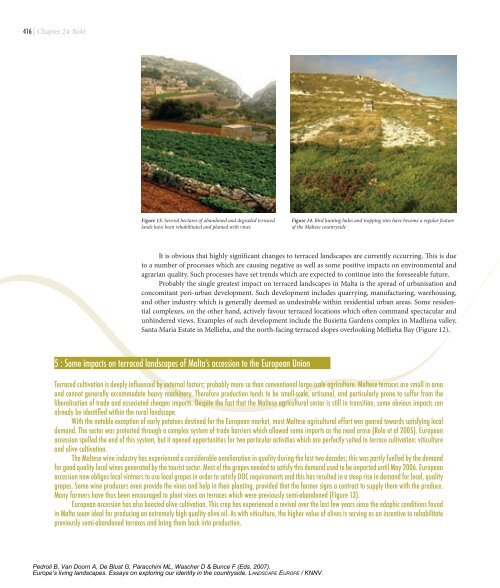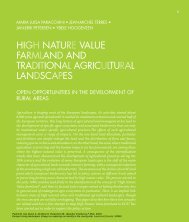The Terraced landscapes of The MalTese Islands - Landscape Europe
The Terraced landscapes of The MalTese Islands - Landscape Europe
The Terraced landscapes of The MalTese Islands - Landscape Europe
You also want an ePaper? Increase the reach of your titles
YUMPU automatically turns print PDFs into web optimized ePapers that Google loves.
16 | Chapter 24: Rolé<br />
Figure 13. Several hectares <strong>of</strong> abandoned and degraded terraced<br />
lands have been rehabilitated and planted with vines<br />
Figure 14. Bird hunting hides and trapping sites have become a regular feature<br />
<strong>of</strong> the Maltese countryside<br />
It is obvious that highly significant changes to terraced <strong>landscapes</strong> are currently occurring. This is due<br />
to a number <strong>of</strong> processes which are causing negative as well as some positive impacts on environmental and<br />
agrarian quality. Such processes have set trends which are expected to continue into the foreseeable future.<br />
Probably the single greatest impact on terraced <strong>landscapes</strong> in Malta is the spread <strong>of</strong> urbanisation and<br />
concomitant peri-urban development. Such development includes quarrying, manufacturing, warehousing,<br />
and other industry which is generally deemed as undesirable within residential urban areas. Some residential<br />
complexes, on the other hand, actively favour terraced locations which <strong>of</strong>ten command spectacular and<br />
unhindered views. Examples <strong>of</strong> such development include the Busietta Gardens complex in Madliena valley,<br />
Santa Maria Estate in Mellieha, and the north-facing terraced slopes overlooking Mellieha Bay (Figure 12).<br />
5 : Some impacts on terraced <strong>landscapes</strong> <strong>of</strong> Malta’s accession to the <strong>Europe</strong>an Union<br />
<strong>Terraced</strong> cultivation is deeply influenced by external factors; probably more so than conventional large-scale agriculture. Maltese terraces are small in area<br />
and cannot generally accommodate heavy machinery. <strong>The</strong>refore production tends to be small-scale, artisanal, and particularly prone to suffer from the<br />
liberalisation <strong>of</strong> trade and associated cheaper imports. Despite the fact that the Maltese agricultural sector is still in transition, some obvious impacts can<br />
already be identified within the rural landscape.<br />
With the notable exception <strong>of</strong> early potatoes destined for the <strong>Europe</strong>an market, most Maltese agricultural effort was geared towards satisfying local<br />
demand. <strong>The</strong> sector was protected through a complex system <strong>of</strong> trade barriers which allowed some imports as the need arose (Role et al 2005). <strong>Europe</strong>an<br />
accession spelled the end <strong>of</strong> this system, but it opened opportunities for two particular activities which are perfectly suited to terrace cultivation: viticulture<br />
and olive cultivation.<br />
<strong>The</strong> Maltese wine industry has experienced a considerable amelioration in quality during the last two decades; this was partly fuelled by the demand<br />
for good quality local wines generated by the tourist sector. Most <strong>of</strong> the grapes needed to satisfy this demand used to be imported until May 2006. <strong>Europe</strong>an<br />
accession now obliges local vintners to use local grapes in order to satisfy DOC requirements and this has resulted in a steep rise in demand for local, quality<br />
grapes. Some wine producers even provide the vines and help in their planting, provided that the farmer signs a contract to supply them with the produce.<br />
Many farmers have thus been encouraged to plant vines on terraces which were previously semi-abandoned (Figure 13).<br />
<strong>Europe</strong>an accession has also boosted olive cultivation. This crop has experienced a revival over the last few years since the edaphic conditions found<br />
in Malta seem ideal for producing an extremely high quality olive oil. As with viticulture, the higher value <strong>of</strong> olives is serving as an incentive to rehabilitate<br />
previously semi-abandoned terraces and bring them back into production.<br />
Pedroli B, Van Doorn A, De Blust G, Paracchini ML, Wascher D & Bunce F (Eds. 2007).<br />
<strong>Europe</strong>’s living <strong>landscapes</strong>. Essays on exploring our identity in the countryside. LANDSCAPE EUROPE / KNNV.




